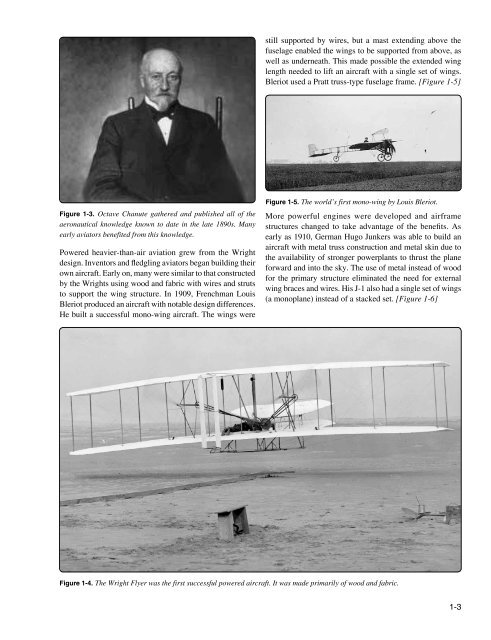Create successful ePaper yourself
Turn your PDF publications into a flip-book with our unique Google optimized e-Paper software.
still supported by wires, but a mast extending above the<br />
fuselage enabled the wings to be supported from above, as<br />
well as underneath. This made possible the extended wing<br />
length needed to lift an aircraft with a single set of wings.<br />
Bleriot used a Pratt truss-type fuselage frame. [Figure 1-5]<br />
Figure 1-3. Octave Chanute gathered and published all of the<br />
aeronautical knowledge known to date in the late 1890s. Many<br />
early aviators benefited from this knowledge.<br />
Powered heavier-than-air aviation grew from the Wright<br />
design. Inventors and fledgling aviators began building their<br />
own aircraft. Early on, many were similar to that constructed<br />
by the Wrights using wood and fabric with wires and struts<br />
to support the wing structure. In 1909, Frenchman Louis<br />
Bleriot produced an aircraft with notable design differences.<br />
He built a successful mono-wing aircraft. The wings were<br />
Figure 1-5. The world’s first mono-wing by Louis Bleriot.<br />
More powerful engines were developed and airframe<br />
structures changed to take advantage of the benefits. As<br />
early as 1910, German Hugo Junkers was able to build an<br />
aircraft with metal truss construction and metal skin due to<br />
the availability of stronger powerplants to thrust the plane<br />
forward and into the sky. The use of metal instead of wood<br />
for the primary structure eliminated the need for external<br />
wing braces and wires. His J-1 also had a single set of wings<br />
(a monoplane) instead of a stacked set. [Figure 1-6]<br />
Figure 1-4. The Wright Flyer was the first successful powered aircraft. It was made primarily of wood and fabric.<br />
1-3



